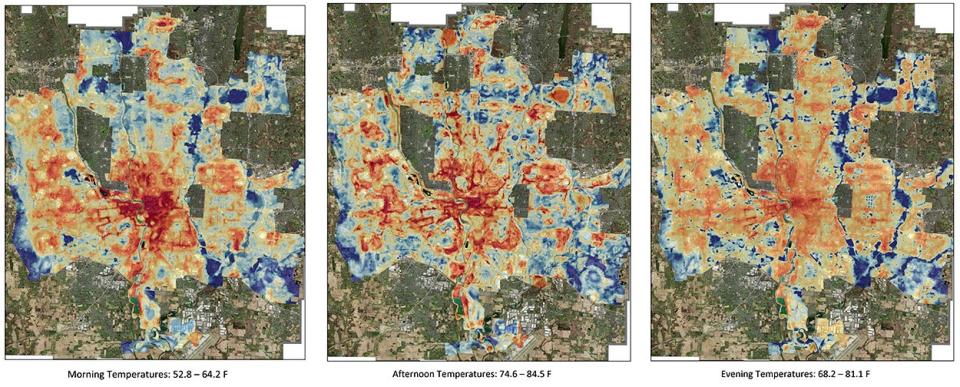Report finds that hottest neighborhoods in Columbus also home to poorest residents
The hottest neighborhoods in Columbus are also the most vulnerable.
Those are the results of a report released Thursday by several local and federal governmental agencies that mapped temperatures across the city this year.
As expected, the hottest neighborhoods were those with the fewest trees, the oldest buildings — which often lack air conditioning — and the poorest residents. Downtown Columbus and the surrounding neighborhoods, Franklinton, and communities on the city's West Side had the highest temperatures, according to the report.

But the temperature variation between neighborhoods surprised researchers. The difference between the coolest communities and the hottest ones is as much as 13 degrees, the report found.
"This is a really important piece of information for us," said Franklin County Public Health Commissioner Joe Mazzola.
The data will help inform the city’s response to climate change and help it protect those most at risk from a warming world, he said.
About the report
Columbus is one of 16 cities participating in a nationwide heat mapping effort.
On Aug. 12, city and county governmental agencies teamed with the National Oceanic and Atmospheric Administration to deploy volunteers throughout Columbus to measure temperatures at several points throughout the day.
Researchers dispatched 78 volunteers early in the morning, in the afternoon, and again in the evening to gauge temperature differences and came away with maps of the hottest parts of Columbus.
Temperatures were highest in the mid-afternoon, when the maximum temperature hit 84.5 degrees Fahrenheit, compared to a minimum temperature of 74.6 degrees. The early morning had a range of 64.2 degrees to 52.8 degrees, and the evening had a range of 81.1 degrees to 68.2 degrees.
What are the hottest neighborhoods in Columbus?
Erin Beck, assistant director for Sustainable Columbus, the city's environmental initiative, said the data can be helpful moving forward.
"Where are the areas where we can concentrate some of our efforts?" Beck said. "This data can help us inform how we are doing that work, and implement it in an equitable way."
Many of the heat islands identified in the report overlap with the city’s so-called opportunity zones, or low-income neighborhoods where developers are eligible for tax breaks in exchange for investment.
Why is heat a problem?
Children, the elderly and people with chronic health conditions are especially vulnerable to the heat.
“From a public health standpoint, it's very important that we focus on our most vulnerable," Mazzola said.
That group also includes laborers who work outside, he said.
Columbus experienced a record number of 90-degree days in June, and emergency room visits spiked as a result.
A heat wave in July 1995 resulted in the deaths of more than 500 people in Chicago and hundreds more across the Midwest, according to the National Weather Service. It's the kind of scenario local officials hope to avoid, even as climate scientists project more frequent and intense heat waves as the world warms.
What to do about it
The city has plans to address some of the underlying problems that cause heat islands or make them worse. An urban-forestry master plan, for example, is intended to improve tree canopy, a move that scientists agree could lower a neighborhood’s temperature by absorbing heat and providing shade.
"We've all walked down a street that doesn't have any trees and then one that does have trees," said Dave Celebrezze, resilience and behavior-change manager for Sustainable Columbus. "It's like drinking a gallon of water to stay hydrated versus drinking a cup of water."
The city’s Climate Action Plan also includes efforts to weatherize homes and make buildings more energy efficient, trapping heat in the winter and releasing it in the summer — moves that could save residents money and help them stay cool during heat waves.
The plan includes resilience hubs, which act as cooling centers during heat emergencies and provide resources to vulnerable communities during natural disasters and power outages. The city is looking to have a hub within a 15-minute walk of everyone in Columbus by 2050.
Officials hope the information in the report helps them better target their efforts, although they acknowledge that communities in the city won’t feel immediate relief.
"It's going to take time for the trees to mature," Celebrezze said.
pcooley@dispatch.com
@PatrickACooley
This article originally appeared on The Columbus Dispatch: Report maps dangerous heat islands in Columbus

